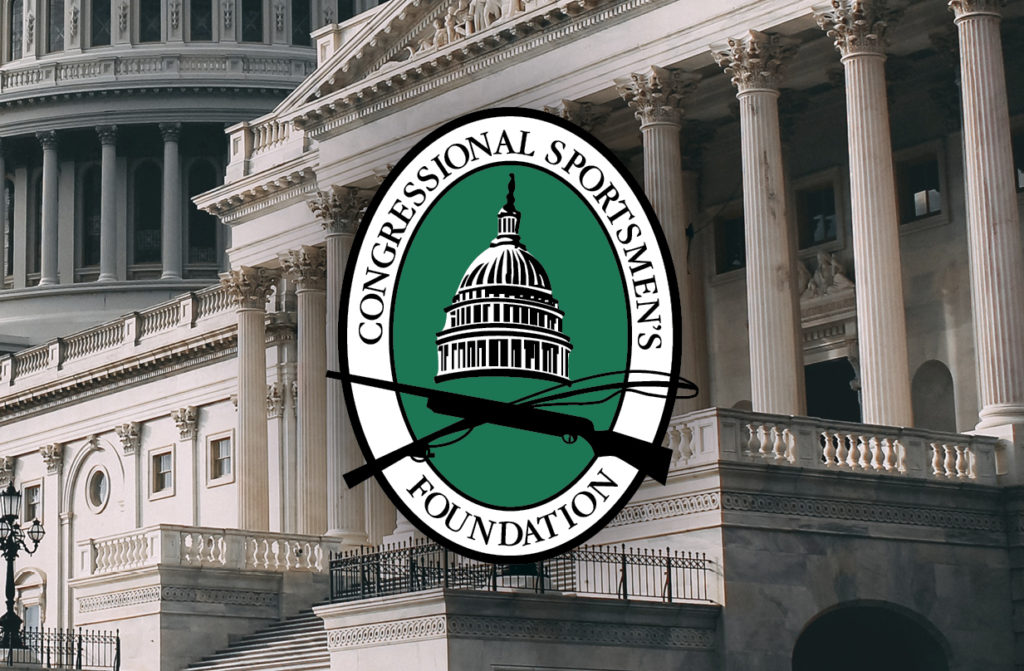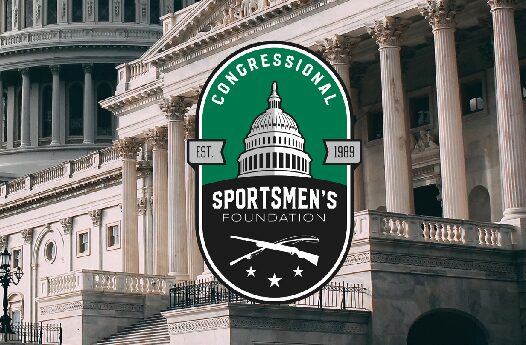Policy Corner Brief: August 2020

CSF Helps Secure Passage of Once-In-a-Lifetime Legislation, Great American Outdoors Act to be Signed into Law
On July 22, the U.S. House passed landmark legislation to promote conservation and access to public lands and waters on a strong bipartisan vote of
310-107. Passage of the Great American Outdoors Act (GAOA) represents the single greatest financial commitment to increasing public land access and opportunities for sportsmen and women in a lifetime, and marks a monumental victory for the Congressional Sportsmen’s Foundation (CSF) in its work on behalf of hunters, anglers, recreational shooters, and trappers.
The Great American Outdoors Act, which passed the Senate last month on a strong vote of 73-25, will provide $9.5 billion over 5 years to address the crumbling infrastructure on America’s public lands and waters. While the National Park Service will receive $6.5 billion in funding, the Congressional Sportsmen’s Foundation (CSF) led a successful effort to secure the inclusion of $3 billion to repair and maintain public land infrastructure overseen by the Bureau of Land Management (BLM), U.S. Fish and Wildlife Service (USFWS), and U.S. Forest Service (USFS), agencies that provide critically important recreational opportunities for America’s sportsmen and women.
“After years of work, we are excited that the Great American Outdoors Act will now become law with the President’s signature. This is a historic victory for sportsmen and women,” said CSF President Jeff Crane. “This legislation will advance conservation, increase access for hunters and anglers, provide much needed support for public lands and waters, and boost the already formidable sporting-conservation economy. CSF extends our sincere thanks to the House and Senate Congressional Sportsmen’s Caucus (CSC) members that championed and voted to support these priorities.”
The inclusion of funding specifically for BLM, USFWS, and USFS lands and waters will ensure that Americans have the ability to access critically important hunting, fishing, and recreational shooting opportunities. Over 246 million acres, or 99%, of BLM lands are open to hunting and fishing while the USFS reports that 99% of the 193 million acres it administers are open to hunting and at least 99% of USFS administered rivers, streams, and lakes are open to fishing. Collectively, BLM, USFWS, and USFS annually support more than 25 million hunting days and nearly 45 million fishing days, highlighting the importance of these lands for America’s sportsmen and women as well as the outdoor economy. Additionally, funding to address these agencies’ maintenance backlog will create over 100,000 employment opportunities
The Great American Outdoors Act also provides full and permanent funding for the Land and Water Conservation Fund (LWCF) at $900 million annually. LWCF is one of the most successful and influential conservation programs in our nation’s history. As a testament to the impact of LWCF, the program has completed a conservation, recreation, or access project in every single county in the country. GAOA also ensures $15 million annually is dedicated to increase public access for hunting, fishing, recreational shooting, and other forms of outdoor recreation.
Alaska Governor Mike Dunleavy Joins Governors Sportsmen’s Caucus to Protect and Advance Sporting Traditions in the Last Frontier
Alaska Governor Mike Dunleavy became the newest member of the Governors Sportsmen’s Caucus (GSC). Governor Dunleavy is the 28th member of the GSC, a bipartisan group of governors from across the country dedicated to protecting and advancing hunting, angling, recreational shooting, and trapping. The Congressional Sportsmen’s Foundation (CSF) is thrilled to have Governor Dunleavy as a member of the GSC.
Governor Dunleavy has been a long-standing supporter of the sportsmen and women of the Last Frontier. Governor Dunleavy has recognized National Hunting and Fishing Day in 2019, Shooting Sports Month in 2020, and Great Outdoors Month in 2020. Governor Dunleavy also joined CSF’s event during the 2020 Safari Club International (SCI) Convention, in Reno, Nevada.
“I’m incredibly grateful for the opportunity to join the Governors Sportsmen’s Caucus. As a life-long hunter and angler in a state where the sporting opportunities are the stuff of legend, I’m excited to join my fellow governors in advancing these important causes,” said Governor Dunleavy.
“We are thrilled to have Governor Dunleavy as a member of the Governor’s Sportsmen’s Caucus,” said CSF President Jeff Crane. “His steadfast commitment to Alaska’s sportsmen and women represents the passion and dedication he has to keep Alaska’s sporting traditions thriving, and we are excited to be able to work alongside him to continue supporting and enhance the Alaskan sporting heritage.”
Founded in 2009 by CSF, the GSC facilitates communication and information exchange among the 28 participating offices in support of professional fish and wildlife management policies and regulations that promote and advance hunting, angling, recreational shooting and trapping.
The Congressional Sportsmen’s Foundation looks forward to working with Governor Dunleavy and his administration to support Alaska’s 563,000 hunters and anglers, who spend $1.16 billion annually and support 15,942 jobs. Working with CSF in a coordinated effort to protect and promote the sportsmen’s traditions in Alaska are members of the Congressional Sportsmen’s Caucus and the Alaska Legislative Outdoor Heritage Caucus, and now the Governor’s Sportsmen’s Caucus.
AGFC Provides Quality Dove Hunting Opportunities
The first day of dove season is often a much-anticipated tradition in the South. While the early September opener (first Saturday of the month for Arkansas) is usually met with lingering summer heat and humidity, it’s the first opportunity for hunters to take to the field and a signal that cooler weather is not far behind. However, for hunters who do not have access to private land managed for doves, finding a good place to dove hunt can be a challenge. The Arkansas Game and Fish Commission (AGFC) is working to overcome that challenge for a few lucky hunters.
In addition to the traditional first-come, first-served public dove fields planted each year on 21 of the AGFC’s existing wildlife management areas (WMA’s), the agency continues to expand on a relatively new program that partners with farmers to provide additional, high-quality dove hunting opportunities on a limited basis. Each year in May, select farmers from around the state enter a contract with the AGFC to plant fields with sunflowers, control weeds, and manage the fields for opening day. The contract includes funding for planting, herbicides, and irrigation (if needed), in addition to leasing the rights for public access for the first 2-3 weekends of the season. More recently, they have expanded the program to corn farmers who are willing to leave some standing corn for hunting stations and who top-sow the harvested field with wheat. The farmer is compensated for the public access opportunity, as well as any corn left in the field. Funding is provided through a leased lands Wildlife Restoration grant, part of the American System of Conservation Funding.
Beginning August 1, hunters apply for the limited hunt opportunity by selecting a field and a preferred weekend through an online application process. Successful hunters will be randomly drawn after the August 15 application deadline, and each permit holder can bring one additional hunter. This fall, a total of 302 private land dove hunting permits will be available.
As the program’s popularity with both farmers and hunters continues to grow, more fields will likely be added in the future as funding allows.
Hunting Coyotes at Night in Missouri, CSF Supports Proposed Regulations
On July 22, the Congressional Sportsmen’s Foundation (CSF) submitted formal comments to the Missouri Conservation Commission in support of changes to Missouri’s furbearer hunting regulations. First reported by CSF on July 6, these regulatory changes were proposed by the Missouri Department of Conservation (MDC) and would create several new opportunities for sportsmen and women who were interested in managing coyote and nuisance wildlife populations using nighttime hunting methods.
CSF’s letter primarily focused on proposed changes that would create a special coyote season during which hunters would be able to use nighttime hunting technologies, including artificial light, night vision, thermal imaging, and infrared optics to hunt coyotes. This proposed change, similar to one currently being considered in Kansas, would allow the use of these technologies during a specific season. In Missouri’s case, this season would occur from February 1 to March 31. In the support letter, CSF applauded the increased opportunity that these proposed regulations would provide for Missouri’s sportsmen and women while reaffirming CSF’s support of state fish and wildlife management agencies as the entity best equipped to make science-based management decisions at the state level.
Also included in the proposed changes was language allowing landowners, and those authorized by the landowner, to use nighttime hunting technologies to hunt feral swine on private lands without prior permission from a Missouri conservation agent. Currently, nighttime technology may be used when hunting feral swine on private lands with prior consent from a state conservation agent.
The public comment period for these proposed changes will remain open through the end of July. Those who wish to provide comments may do so by visiting MDC’s website.
Restoring Ruffed Grouse in Indiana remains Goal for CSF in Midwest
On July 29 and 30, the Indiana Natural Resource Commission held public hearings regarding their Biennial Wildlife Amendments, which are proposed changes to the state’s wildlife regulations. Included in the amendments was the listing of the ruffed grouse as a state Endangered Species in Indiana. CSF submitted a letter of support for the listing, which again called for the swift implementation of a strong action plan focused on sound, science-based wildlife and forestry management practices with clearly defined goals and benchmarks for recovery.
Ruffed grouse were once a popular game bird across the Hoosier State. However, by 1983, it was confirmed that ruffed grouse had been extirpated from 43 of the state’s 92 counties. Today, it is believed that these birds only inhabit a very small portion of southern Indiana. In 2015, Indiana suspended the ruffed grouse hunting season, and ruffed grouse were listed as a “Species of Special Concern” by the state.
In recent years, CSF has been at the forefront of this issue, working with legislators, the Indiana Department of Natural Recourses, the Indiana Natural Resource Commission, and conservation partners to promote science-based wildlife and forestry management practices in the state. Additionally, CSF has worked to educate those unfamiliar with the issue on the negative ramifications that poor forestry management can have on both the forests and wildlife. Forest management is a hotly contested issue in Indiana, and all sides of the issue were represented at the public hearings, regarding the listing of the ruffed grouse. The Natural Resource Commission will review the comments and make a final decision on the listing of the Ruffed Grouse at a meeting later this year.
CSF is resolved to continue our work in Indiana to promote science-based management practices with the goals of not only returning ruffed grouse to a sustainable abundance that allows for the re-establishment of a hunting season for Indiana sportsmen and women, but to also ensure that public policy supports the health of all forests and wildlife in the state.
USFWS Revises Rhode Island National Wildlife Refuge Complex Hunting and Fishing Plan
Rhode Island’s sporting community may have additional hunting and fishing opportunities headed its way, as a the U.S. Fish and Wildlife Service (USFWS) recently published the 2020 Final Hunting and Fishing Plan (Plan) for the Rhode Island National Wildlife Refuge (NWR) Complex. While the Plan does vary from what was initially proposed by the USFWS in March (March Plan), the revised Plan would certainly provide additional benefits to hunters and anglers on the Rhode Island NWR Complex.
Consistent with the earlier Plan, Block Island NWR would be open for the hunting of whitetail deer on all 133 available acres, while 9 acres would permit migratory waterfowl hunting. At John H. Chafee NWR, the USFWS seeks to open 451 acres for the hunting of deer, wild turkey, fox, and coyote – accounting for 97% of the area initially proposed (461 acres) under the March Plan and 80% of the refuge’s total real estate (563 acres). In similar fashion, almost all 883 acres on Ninigret NWR would permit the hunting of whitetail deer, wild turkey, and certain predator species. Additionally, opportunities would be available at Sachuest Point NWR for archery hunters through the opening of 150 total acres for their pursuits. Finally, at Trustom Pond NWR, the Plan has called for an authorization of archery hunting on 358 acres on the refuge’s western region.
In early June, the Congressional Sportsmen’s Foundation (CSF) submitted testimony to the Rhode Island NWR in support of the March Plan. CSF remains supportive of the increased hunting and fishing opportunities that the final Plan would bring, and will remain engaged with the USFWS on this matter. For more information, please follow this link.
SHARE ON
You may also like
The role corn plays for gamebirds and economies ac...
Sportsmen’s conservation policy issues from publ...
Sportsmen’s conservation policy issues from publ...


























